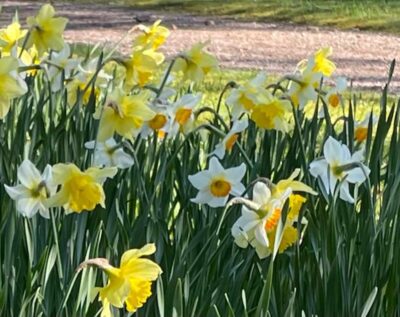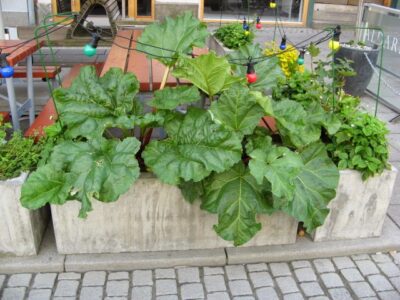Although it was a dreich day on Good Friday, we got the waterproofs out and headed for Alnwick Gardens in Northumberland. Garden designer, Jacques Wirtz recently designed these gardens and development is still ongoing. We wondered through the bamboo maze, watching children squealing with delight as they splashed around in the water garden. After exploring the ornamental garden, we thought we’d investigate the Poison Garden. We were not permitted to enter the area unsupervised, but what the tour guide had to say was fascinating.
Who knew such seemingly beautiful plants could have such a sinister underside?
Daffodils
 Daffodil bulbs are toxic and cause stomach upsets, though folk rarely end up in hospital from eating them. There are reports of bulbs been dug up and popped in the cooking pot, mistaken for shallots. Squirrels and rabbits are aware of their unpleasant side effects and know to leave them alone, which can obviously be an advantage in the garden.
Daffodil bulbs are toxic and cause stomach upsets, though folk rarely end up in hospital from eating them. There are reports of bulbs been dug up and popped in the cooking pot, mistaken for shallots. Squirrels and rabbits are aware of their unpleasant side effects and know to leave them alone, which can obviously be an advantage in the garden.
Scientists recently found that daffodils have a therapeutic value in the treatment of Alzheimer’s disease. They contain the substance galantamine, which eases the symptoms of memory loss and dementia and can even slow the progression of this disease in some patients. Daffodils are now being farmed on Welsh hillsides specifically for the pharmaceutical industry for this purpose.
Foxgloves

I am sure that many of us are familiar with the fact that Foxgloves are poisonous. Through history, folk have attempted to bump off their victims using the poison from foxgloves. Foxgloves contain the chemical digitoxin, which affect the heart muscles and slow the heart rate. As a result, victims suffer from heart attacks and deprivation of oxygen to the brain. Reassuringly, Foxgloves are also an emetic, so are likely to cause vomiting before any real harm can be done. Digitoxin can be of therapeutic value and is used in the treatment of heart failure.
Hellebores

I had no idea that Hellebores were on the list of poisonous plants? If you dug up the roots and ate them, you would be likely to suffer a strong attack of vomiting and this may even be fatal. Hellebores were used historically as a remedy for expelling worms from children by causing vomiting. Luckily we have discovered better treatments since then!
Juniper
Juniper bushes contain high levels of isocupressic acid, which causes abortions in pregnant women. It is thought to have been used for aborting unwanted children in the past. Juniper berries are used to flavour gin, which is also known as ‘Mother’s ruin’ for this reason.
Opium Poppies

Opium poppy seeds are used to make the narcotic drugs, morphine and heroine. Not surprisingly these plants have been responsible for thousands of deaths every year in Europe as a result of overdose. However, as with many of the other poisonous plants discussed here, morphine is also a pain killer. Poppies are also farmed for their therapeutic properties and are exploited by the pharmaceutical industry.
Rhubarb

Rhubarb leaves are poisonous and should not be ingested as they contain oxalic acid which causes internal bleeding. The stalks however are very nutritious and delicious. They too can be used therapeutically as they contain anthraquinones and can be used as a laxative in cases of constipation.
But don’t panic…
It was fascinating to dig up so many facts about many plants that I thought were harmless. However, before everyone goes out and concretes over their back garden, instances of accidental plant poisoning are incredibly rare and even in these cases, symptoms are hardly ever severe.

